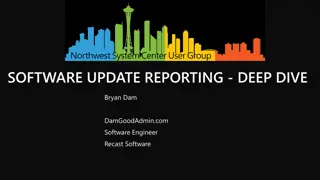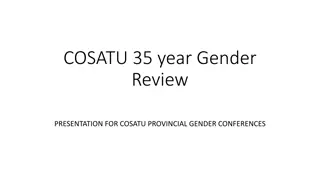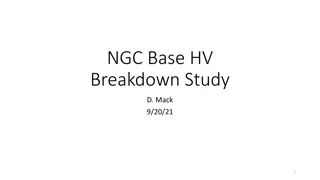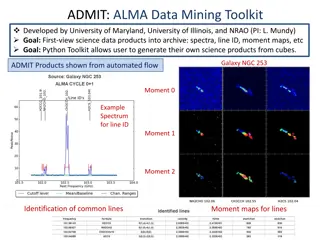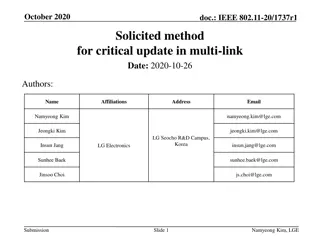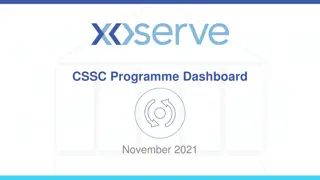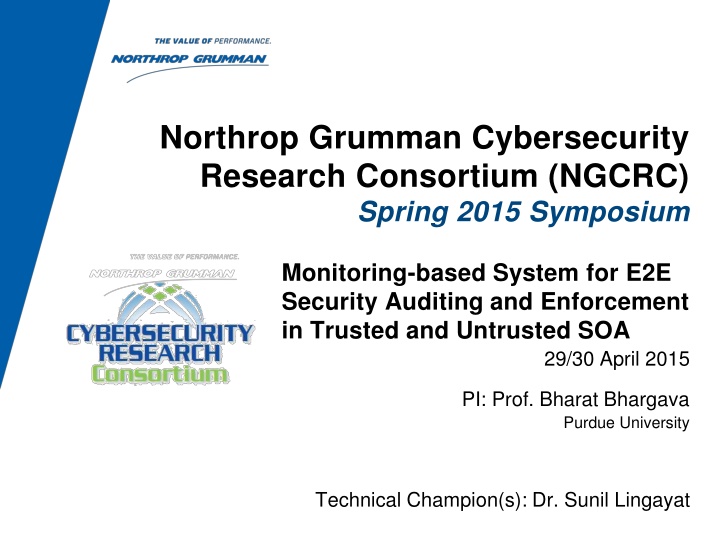
NGCRC Cybersecurity Research: End-to-End Security in Service-Oriented Architecture
The Northrop Grumman Cybersecurity Research Consortium's (NGCRC) Spring 2015 Symposium focused on Monitoring-based System for E2E Security Auditing and Enforcement in Trusted and Untrusted SOA. The research delved into high-security assurance in SOA, agile defense, resilient service monitoring, anomaly detection, service trust management, dynamic service composition, SLA enforcement, data privacy, secure information exchange, and controlled data dissemination. Project participants included Prof. Bharat Bhargava, Dr. Pelin Angin, Rohit Ranchal, Denis Ulybyshev, Prof. Leszek Lilien, and Dr. Lotfi ben Othmane. The research components encompassed policies, passive and active listeners, authorization, trust management, agile defense, anomaly detection, and more.
Download Presentation

Please find below an Image/Link to download the presentation.
The content on the website is provided AS IS for your information and personal use only. It may not be sold, licensed, or shared on other websites without obtaining consent from the author. If you encounter any issues during the download, it is possible that the publisher has removed the file from their server.
You are allowed to download the files provided on this website for personal or commercial use, subject to the condition that they are used lawfully. All files are the property of their respective owners.
The content on the website is provided AS IS for your information and personal use only. It may not be sold, licensed, or shared on other websites without obtaining consent from the author.
E N D
Presentation Transcript
Northrop Grumman Cybersecurity Research Consortium (NGCRC) Spring 2015 Symposium Monitoring-based System for E2E Security Auditing and Enforcement in Trusted and Untrusted SOA 29/30 April 2015 PI: Prof. Bharat Bhargava Purdue University Technical Champion(s): Dr. Sunil Lingayat
Project Participants Prof. Bharat Bhargava Dr. Pelin Angin Rohit Ranchal, PhD student Denis Ulybyshev, PhD student Prof. Leszek Lilien Dr. Lotfi ben Othmane 2
2014/2015 Research Focus High security assurance in SOA Agile defense Resilient and Adaptable service monitoring Anomaly detection (failed, compromised or malicious services) Service Trust management Dynamic service composition Ensure the enforcement of SLAs in real time Data privacy in SOA Secure cross-domain information exchange Privacy-preserving controlled data dissemination 3
Potential End-to-End Scenario using 3 NGCRC Projects (preliminary notional draft concept!) High security assurance in SOA Service Selection based on trust level of user (1) (2) Secure Browser User Authenticate to browser (trusted e.g. CAC or untrusted e.g. PIN) Request data processing User Machine Trusted Service Encrypted Data Processing Untrusted Service Data Processing (3) NGCRC Projects Univ. Data (potentially corrupted) Secure Hardware Tokens and Key Storage in the Browser End to End Security Policy Auditing and Enforcement in Service Oriented Architecture Ensuring Privacy in Cloud-based Data Analysis Encrypted Data MIT (1) Purdue (2) Untrusted Cloud Untrusted Cloud Purdue (3) Northrop Grumman Private / Proprietary Level 1
Problem Domain: Service Attack Service B PII Service A Service C Service D Trust Domain 5
Problem Domain: Service Failure Service B PII Service A Service C Service D Trust Domain 6
Problem Domain: Data Leakage Service B PII PII Service A PII Service C Service D Trust Domain 7
Research Components Policies Passive Listener Active Listener Active Bundle Listener Heartbeat Module Authorize Log Trust React Analyze Management Agile Defense Detect Resiliency & Adaptability Anomaly Detection 8
Agile Defense Goals: Replace anomalous services with reliable versions Reconfigure system service orchestrations to respond to anomalous service behavior Swiftly self-adapt to changes in context Enforce proactive and reactive response policies to achieve system security goals Continuous availability even under attacks Components: Detection of anomalies Hot re-deployment of anomalous (failed/attacked) services Dynamic service composition 10
Adaptability for Increased Resilience Dynamic service reconfiguration based on changes in context: Updated priorities (e.g. response time vs. level of detail/accuracy) Updated constraints (e.g. need to have trust levels of all services > x for critical mission) Replacing failed services in composition with healthy ones dynamically to avoid complete restart of process Monitor services status and determine action Adapt services in a domain in response to attacks/failure Update service health status in case of significant deviations from normal behavior Create service backup in case of suspicion of anomaly Re-deploy service in case of complete failure Controlled sharing of data: Determine sharing of data based on the requirements and authorization level of the subscriber Limit data shared based on trust level of subscriber Controlled dissemination based on contexts such as safe environment, attack scenario 11
Agile Defense Research Problems How to detect changes in service context Centralized or distributed monitoring? What service behavior constitutes context change? What is the most effective and efficient way to detect anomalies? How to react to changes in context across domains What is the most effective way to create fail-safe service orchestrations? How can we efficiently reconfigure an orchestration to take into account the new context? How can we tailor the response based on the extent, duration and type of anomalies? How to balance costs and benefits of adaptability 12
Anomaly Detection by Service Monitoring Service monitor in each domain tracks all incoming requests to service domain, which allows gathering of the following data: Service response time (excluding network delay) (increased delay in service response can be the sign of an attack) Service heartbeat data (each served request is a sign that the service is up and running) Service response status (particular response codes signify problems in the service) Service authorization/authentication failure data (consecutive authorization/authentication failures can signify attacks) Active bundle interaction logs are also utilized to detect service anomalies (unauthorized data interactions, active bundle integrity violations etc.) 13
Distributed Service Monitoring for Cross-domain Anomaly Detection and Adaptability S4 * * S5 MB S6 S1 * * Domain B S7 * S2 * * MC S9 MA * S3 Domain C * Domain A * * S10 S11 * * * * * S12 ME MD Domain E Domain D Central Monitor *: service request data *: summary service health data 14
Distributed Service Monitoring for Cross-domain Anomaly Detection and Adaptability Distributed service monitoring allows for the collection, analysis and reaction to dynamic cyber events across all domains involved, and prevents propagation of threats within or outside the domain of the anomalous service by taking proactive measures (service isolation, replication). The data (service requests, service performance data etc.) gathered by the monitor Mx of each service domain x is stored in the monitoring database of the domain. Service monitoring is distributed across domains, with one monitor for each domain. Each monitor is responsible for reporting the health status of the services in its own domain to the central monitor. Service monitor of each domain mines the data stored in its database to detect anomalies with services in the domain and takes measures accordingly (re-deployment, backup service creation). Service monitor of each domain sends summary health status data of services to the central monitor, which is utilized for dynamic service composition. 15
Anomaly Detection Approach Statistical analysis of multivariate time-series data collected by service monitors to detect significant deviations from normal behavior Adjusts service threat levels based on duration, extent & type of anomalies Correlation of time-series data from multiple services allows for detection of bigger threats (affecting the whole domain, collaborative attacks etc.) Detecting previously unseen attacks as opposed to signature-based models 350 Service response time 300 250 200 (ms) 150 100 50 0 Time (-->) Threat level = 3 Threat level = 0 16 Threat level = 1
Anomaly Detection Approach 140 Diagnosis: Anomaly affecting S1 Response: replace S1 # of authentication 120 100 failures 80 S1 S2 60 S3 40 20 0 time (-->) Diagnosis: Anomaly affecting whole domain Response: re-deploy all services in different domain / switch to backup versions in different domain 60 50 CPU usage (%) 40 S1 30 S2 S3 20 10 0 time (-->) 17
Hidden Markov Models for Anomaly Detection Investigating Hidden Markov Models (HMMs) for detection of anomalies in time series data HMM: The simplest dynamic Bayesian network Model consists of states X and an observation sequence (output tokens) Y, whose probability of occurrence depends on the state States are hidden, but outputs of each state is observed Sequence of observations are related to each other rather than independent Each state has a probability for generating certain output and probability of transition to another state Task: Given the model s parameters and a sequence of observations, compute the distribution over the hidden states of the last variable in the sequence 18
Hidden Markov Models for Anomaly Detection aij: State transition probabilities bij: Output probabilities Xi: States (normal, attack, high load, failure etc.) yi: Observations ({low response time, high response time, normal response time}, {high CPU usage, no CPU usage, normal CPU usage} ) Train HMM with service operation data under normal conditions (to detect anomalies) Merge with measure of distance between different sets of time-series data to assess significance of deviation from normal 19
Hot Re-deployment of Failed/Compromised Services The service monitor of each domain stores a copy of each service implementation in its domain in a repository, so they can be re-deployed in case of failure. Problems in the request of a failed service are also detected by the service monitor, which can redirect the request to a backup service with the same capability if one exists (otherwise re-deployment process is initiated) Services in failed status (upon detection by the monitor) are replaced with a fresh copy from the repository, and their deployment time field in the database is updated to the time of deployment. In case of detection of a possible service anomaly, the service monitor can initiate a backup service deployment in the same domain or in another domain (such as a cloud application server). Service deployment takes place through copying the service bundle from the repository into the target service domain. Upon service deployment, all relevant information about the new service is logged in the service monitor s database. The dynamic service composition module utilizes this data to determine whether the service will be part of a specific orchestration. 20
Dynamic Service Reconfiguration An SOA service orchestration is composed of a series of services that interact with each other based on a service interaction graph One of the multiple services in each service category can be selected for specific service functionality, e.g. category: weather, services: weather.com, Yahoo weather, accuweather Challenge: Configuring set of services that conform to QoS and security policy requirements Dynamically reconfigured service composition is based on changes in the context with respect to timeliness and accuracy of information as well as the type, duration, extent of attacks and the complexity of the environment 21
Dynamic Service Reconfiguration Developed a module that dynamically determines the service endpoints involved in a specific composition Given the description of a business process (service composition) including the categories of the services involved in the process, the dynamic service composition module updates the process with specific service endpoints to be utilized in that process. The dynamic service composition mechanism allows services meeting specific requirements to be included in a composition Utilizes service and interaction data logged in the central database to create the best possible composition given a service request with policy specifications Enables the dynamic replacement of failed services in a composition with services of equivalent capability to prevent interruption of tasks Dynamic replacement of service endpoints implemented in compliance with the BPEL standard for service composition, using dynamic partner links Apache ODE engine used for the deployment of the composed processes 22
Dynamic Service Composition Approach The problem is an instance of the multiple-choice multiply-constrained knapsack problem (MMKP): tij: utility of service j in category i xij: indicator for participation in a service composition (of service j in category i) cijk: value of service j in category i for constraint category k Ck: threshold value for constraint category k Si: set of services in category i p: number of constraints m: number of service categories MMKP is NP-hard, therefore we use a greedy heuristic-based approach to find near-optimal solutions 23
Dynamic Service Composition Algorithm //Input: A set of mservice categories Si, each with a set of concrete services. //Output: A set of services, one in each category, with near-optimal utility based on context. sort services in every category in descending order of utility for i: 1..m xi1 = 1 // select the highest utility service for the initial composition if return current composition //solution satisfies constraints else while solution not feasible //downgrade using the service with biggest aggregate saving in constraints for each category i for each service j in i calculate aggregate saving of service in category i of the current composition with j find service j with maximum aggregate saving find service with max aggregate saving across all categories, include in the composition return composition 24
Dynamic Service Composition Experiments Dynamic service composition overhead is especially important in time-critical settings Measure response time overhead of dynamic service composition for: (1)Different number of service categories in a composition (2)Different number of services to choose from for each category Setting: Central service monitor on Amazon EC2 m3.medium instance (1 vCPU, 3.75 GB memory) Composition time dominated by the database access time and not affected significantly by the number of possible services in a category or the number of service categories involved in the composition. Composition overhead reasonable for most settings. Composition involving 3 service categories, with varying number of services for each category Composition involving varying number of service categories, with 3 possible services for each category 800 800 Composition time Composition time 700 700 600 600 500 500 (ms) (ms) 400 400 300 300 200 200 100 100 0 0 3 5 10 20 3 5 10 20 number of service categories number of services per category 25
Adaptability Cost and Benefit Consideration Benefits: Increased availability of services (measured by up-time and throughput) Increased performance by obviating the need to restart invocations of service compositions with failed/attacked services (measured by total response time) Increased security and flexibility in service composition based on priorities and constraints in a specific environment (measured by success of avoiding attacks) Costs: Dynamic service composition time cost Cost to maintain central service monitor Service response delay due to monitoring Increased resource usage in service domain Overhead of re-deploying service in same/different domain 26
Demo Scenario A Carrier Strike Group with one carrier and four Littoral Combat Ships (LCSs) is deployed for a surveillance mission in a dangerous area. A Northrop Grumman X- 47B, an Unmanned Combat Air System (UCAS) is deployed from the carrier for the surveillance of the whole Area of Responsibility (AOR) of the LCS/CSG force. The surveillance mission also involves unmanned aerial vehicles (UAVs) that perform video surveillance functions in the AOR. The UCAS periodically contacts the gateway of the underwater acoustic array to receive a report from it. Radar plots from the ships and video frames from the UAVs are gathered by the UCAS and analyzed together for accurate identification of objects in the area. 27
Demo Scenario (cont.) The analysis process is a composition of three services: S1: Radar plot integrator: This service integrates together radar plots from multiple sources to present a unified plot of the whole area. S2: Radar plot analyzer: This service analyzes a radar plot to detect locations of suspicious objects. S3: Video frame analyzer: This service analyzes a stream of video frames to identify objects in a scene given their coordinates. The analysis process invokes the radar plot integrator service first, which provides an integrated plot fed into the radar plot analyzer service. The radar plot analyzer service outputs the locations of significant objects from the plot, which are input to the video frame analyzer to identify the types of the objects and decide whether they pose any threat. 28
Demo Scenario (cont.) Demonstration of system capabilities: 1. Adaptation to context changes: As long as the reports from the underwater acoustic array show a low threat level, the policy for the analysis process will be to perform detailed analysis with no or little preference for short response time. The context will change from normal to emergency when the report includes the presence of a suspicious watercraft. The context change will affect the service composition (as a result of dynamic service composition, services providing faster response will replace services providing very detailed analysis at the cost of longer response time). 2. Adaptation to attacks on services: The demo will show how the analysis process composition will change dynamically as a result of a DoS attack on one of the services involved. 3. Adaptation to service failures: We will show how the failure of one service in the composition will trigger the hot deployment of the same service and the redirection of the request to the newly deployed service to prevent interruption. 29
Further Research Tasks and Plans Integrating more parameters into anomaly detection process (CPU usage, memory usage etc.) Implementation of HMMs for anomaly detection Experiments with anomaly detection: Time to detect anomaly after start of attack Accuracy of anomaly detection model Experiments with service monitor: Scalability of central monitor Service response delay due to monitoring Service throughput with monitoring Adaptability experiments: Multiple constraints in dynamic service composition Cost-benefit analysis of dynamic service composition (in terms of response time overhead) Overhead of re-deploying service in same/different domain 30
Privacy Preserving Data Dissemination in SOA 31
Problem Statement Composite Web services Loosely coupled independent RESTful services composed to accomplish a task A composite service invocation translates into multiple interactions that may share user data Opaque data sharing across unknown endpoints beyond primary service Undetected privacy violations due to data sharing with unauthorized services Lack of policy infrastructure Inability of owner to specify data access policies for secondary services authorization Policy definition, communication, evaluation and enforcement Message-based security mechanisms (HTTPS) are not applicable Provides point-to-point secure communication Unable to provide protection in remote domains 32
Motivation 33
Research Objectives Demonstrate policy-based distributed data dissemination Demonstrate distributed policy communication, evaluation and enforcement framework Demonstrate scenarios for controlled cross- domain information exchange under various anomalies and attacks 34
Research Tasks How to ensure that each authorized subscriber service only accesses the data for which it is authorized How to prohibit data dissemination to an unauthorized subscriber service Demonstrate applications (such as Electronic Healthcare Records, UAVs) under different data dissemination models: Publish-Subscribe Peer-to-Peer Mutable (interacting services can update data and policies in Active Bundle) Immutable Demonstrate compatibility with existing service infrastructure such as RESTful services (HTTP) 35
Proposed Solution if (host == authorized) F(ki, P, C) = di 36
Proposed Solution Practical implementation of function F, policy P, and ciphertext C Active Bundle approach for secure data dissemination Active Bundle (AB) Self-protecting encapsulation mechanism for protecting data Provides secure cross-domain information exchange Metadata Access control policies Operational policies Virtual Machine Protection mechanism (self-integrity check) Policy evaluation, enforcement and data dissemination Iden ty? informa on? Data? integrity? checks? Access? control? policies? Dissemina on? policies? Life? dura on? ? Metadata? Sensi ve? ? Data? Interprets? metadata? Checks? ac ve? bundle? integrity? Enforces? access? and? ? dissemina on? control? policies? Policy? enforcer? (VM)? 37
Framework Components Host authentication Password, Certificate, Biometric, PKI Host request authorization (policy evaluation) Access control model such as Attribute/Role-based Policy specification language such as XACML/JSON Policy evaluation engine such as WSO2 Balana/Java-based Key management methods Key inclusion (prone to attacks) Key management service (use of trusted third party for key storage and distribution) Key derivation based on the AB execution control flow path Key derivation based on the unique information generated in control flow steps only if the service is authenticated and authorized Tamper Resistance Correct data dissemination depends on the correct execution of AB control flow steps Verify the integrity of the execution to ensure there is no difference from the original code Integrity verification is based on digest calculation using secure one-way hash function Each time an AB step is executed, the tamper resistance module calculates its digest and the digest of its resources Digests are used to derive decryption keys Any modification to AB changes the digest resulting in incorrect key derivation 38
Data Dissemination Models Publish-Subscribe Dissemination Data published by various sources to a central repository and shared with various subscribers by means of Active Bundles (AB) Peer-to-Peer Dissemination Data shared among peers of different classification level by means of AB Immutable Dissemination Fixed data shared by means of AB with various parties in an information flow chain Mutable Dissemination Data shared by means of AB can be dynamically updated by the interacting parties in an information flow chain 39
Publish-Subscribe Dissemination (Healthcare) Doctor Nurse Active Bundle Active Bundle Active Bundle Medical Information System Laboratory Active Bundle Active Bundle Patient ID Insurance ID Medical data Medical history Medical test prescription Prescription Treatment code Insurance Pharmacy 40
Publish-Subscribe Dissemination (Healthcare) Patient ID Medical data E(Insurance ID) E(Medical history) E(Medical test prescription) E(Prescription) E(Treatment code) Patient ID Medical data Medical history Medical test prescription Prescription E(Insurance ID) E(Treatment code) Doctor Nurse Active Bundle Active Bundle Active Bundle Medical Information System Laboratory Patient ID Insurance ID Treatment code E(Medical data) E(Medical history) E(Medical test prescription) E(Prescription) Active Bundle Active Bundle Patient ID Medical test prescription E(Medical data) E(Insurance ID) E(Medical history) E(Prescription) E(Treatment code) Patient ID Insurance ID Medical data Medical history Medical test prescription Prescription Treatment code Insurance Pharmacy Patient ID Prescription E(Medical data) E(Insurance ID) E(Medical history) E(Medical test prescription) E(Treatment code) 41
Peer-to-Peer Dissemination (UAVs) UAV 1 UAV 2 UAV 3 Command & Control Time period Deployed personnel Target locations Intelligence reports Mission expenses Deployed weapons Casualties Press Release Top Secret Confidential Unclassified Secret 42
Peer-to-Peer Dissemination (UAVs) Multispectral imagery Location coordinates Infrared imagery Location coordinates UAV 1 UAV 2 UAV 3 Time period Deployed personnel Target locations Intelligence reports Mission expenses Deployed weapons Casualties Press Release Command & Control Time period Deployed personnel Target locations Intelligence reports Mission expenses Deployed weapons Casualties Press Release Top Secret Confidential Unclassified Secret Target locations Intelligence reports Mission expenses Deployed weapons Press Release Mission expenses Press Release Press Release 43
Mutable Dissemination (Healthcare) Name Patient ID Medical data History Medical test prescription Prescription General Practitioner AB2 AB3 AB4 AB3 AB1 Laboratory Surgeon Nurse Name Patient ID Medical test prescription Prescription Medical data History Patient ID Medical test prescription Medical data Name Patient ID Medical data Name Patient ID Pharmacy Purple data update Black data access Patient ID Prescription 44
Immutable Data Dissemination (Online Shopping) 45
Immutable Data Dissemination (Online Shopping) 46
Implementation RESTful Web services SOA implementation using Node.js AB implementation as an executable JAR file AB API implementation using Apache Thrift RPC framework Policy specification in XACML/JSON Policy evaluation using WSO2 Balana AB transfer by means of REST message (HTTP body) AB API exposed to services: getSLA() getValue(req, sigReq, cert) getSecureValue(req, sigReq, cert) 47
Access Policy Examples Credit card access policy (Attribute-based): Deny Resource Subject: CA signed certificate Action Environment: Service trust Credit card Visa payment services READ < 9 Medical data access policy (Role-based): Deny Resource Subject: Role Action Environment: Subject rating Medical prescription Doctor, Patient READ < 4 star 48
Access Policy Examples Cross-domain data access policy (Context-based): Deny Resource Subject: Classification Action Environment: Attack context Intelligence reports Top secret READ Secret, Confidential Medical data access policy (Context-based): Deny Resource Subject: Role Action Environment: Emergency context Medical prescription Dr. A, Patient READ Paramedics, Doctors 49
Attack Resilience Trusting the AB and its execution Digital signatures to validate the authenticity and integrity of AB Containerized execution of AB (e.g. using Docker containers) Cloud-based execution Protecting AB against malicious receivers Tamper resistant code (code integrity checks) Correct secret key generation only in case of correct execution Cloud-based execution (third party code execution vs third party data broker) Protecting AB execution against control flow hijacks Code obfuscation Write protected memory execution TPM - based remote attestation using chain of trust (Trusted Computing Group work) [https://www.trustedcomputinggroup.org/faq/TPMFAQ/] 50


